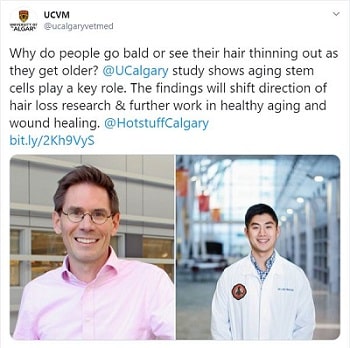Update: April 2020 — Dr. Jeff Biernaskie and his team (led by graduate student Wisoo Shin) just made an important new discovery. They found that hair loss is caused by progressive dysfunction of message-sending fibroblasts due to aging dermal stem cells. Fully functioning dermal stem cells are required to maintain fibroblast populations. The actual paper is published in Developmental Cell.
Apparently, hair loss research to date has mostly focused on keratinocytes, the cells that make up the bulk of the hair follicle. However, a loss of dermal stem cells prevents production of new fibroblasts. Fibroblasts in the hair follicle are crucial, since they send messages to the keratinocytes. These messages tell the keratinocytes when to divide, which in turn orchestrates the repeating cycles of hair follicle growth and shedding.
These latest findings will also impact research into skin regeneration and wound healing.

Update: February 2015 — An interesting and fairly technical article on dermal cups and dermal stem cells. Includes a great summary of the recent work by Dr. Jeff Biernaskie as well as a brief mention on Replicel’s approach.
December 2014
Jeff Biernaskie and Dermal Stem Cells
Earlier this month, a team led by Dr. Jeff Biernaskie (from the Biernaskie Lab at University of Calgary in Canada) got their hair related research findings published in the journal Developmental Cell. This research identifies the existence of hair follicle dermal stem cells in adults. These can potentially be targeted to stimulate new hair growth in areas where there has been hair loss.
More detailed information can be read via the Calgary Herald.
Although this was interesting research that was widely covered in the media, I was not too impressed. Besides the fact that this was yet again research only done in mice, it seems like Dr. Biernaskie himself is a professor in the veterinary department! Moreover, most of the articles that I read on this development suggested that these findings could only lead to a potential cure in 10 years at best.
With the seemingly exponential growth in science and technology in recent years, 10-year time frames are usually a bit underwhelming. Nevertheless, after writing my prior post on hair loss research at the University of Bradford, now seemed like a good time to praise a Canadian university. It should be noted that other researchers from: Kyoto University in Japan; University of North Carolina at Chapel Hill in the US; and Université de Strasbourg in France; were also involved in this research.
More interesting, two days ago RepliCel published an article covering this study. They think that these findings validate Replicel’s RHC-01 product, which utilizes dermal sheath cup cells.

